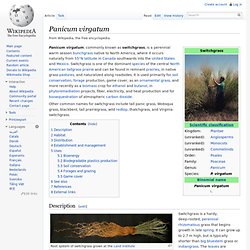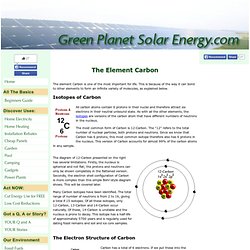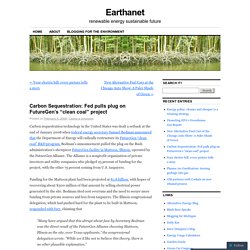

A winning solution for renewable energy and CO2 reduction? Two scientists are proposing the use of high-pressure carbon dioxide, instead of water, for extracting geothermal heat from the Earth Image Gallery (2 images) A promising new innovation in geothermal technology, that offers a novel solution to climate change, has been created by two researchers from the University of Minnesota's Department of Earth Sciences.

The technology focuses on tapping heat from beneath the Earth's surface. By using high-pressure carbon dioxide (CO2) instead of water to extract the heat, the system has the potential to produce significantly more efficient renewable energy. At the same time, by sequestering CO2 deep underground, it actively reduces atmospheric CO2. The approach, coined the CO2-plume geothermal system (or CPG) was discovered by Earth sciences faculty member Martin Saar and graduate student Jimmy Randolph, in the University of Minnesota's College of Science and Engineering. Saar and Randolph are now planning to move the CPG into the pilot phase. Panicum virgatum. Panicum virgatum, commonly known as switchgrass, is a perennial warm season bunchgrass native to North America, where it occurs naturally from 55°N latitude in Canada southwards into the United States and Mexico.

Switchgrass is one of the dominant species of the central North American tallgrass prairie and can be found in remnant prairies, in native grass pastures, and naturalized along roadsides. It is used primarily for soil conservation, forage production, game cover, as an ornamental grass, and more recently as a biomass crop for ethanol and butanol, in phytoremediation projects, fiber, electricity, and heat production and for biosequestration of atmospheric carbon dioxide. Other common names for switchgrass include tall panic grass, Wobsqua grass, blackbent, tall prairiegrass, wild redtop, thatchgrass, and Virginia switchgrass.
Description[edit] Habitat[edit] Distribution[edit] Switchgrass is a versatile and adaptable plant. Establishment and management[edit] Uses[edit] Bioenergy[edit] The Element Carbon. The element Carbon is one of the most important for life.

This is because of the way it can bond to other elements to form an infinite variety of molecules, as explained below. Isotopes of Carbon All carbon atoms contain 6 protons in their nuclei and therefore attract six electrons in their neutral unbound state. Carbon sequestration. Carbon sequestration is the process of capture and long-term storage of atmospheric carbon dioxide (CO 2)[1] and may refer specifically to: "The process of removing carbon from the atmosphere and depositing it in a reservoir.

"[2] When carried out deliberately, this may also be referred to as carbon dioxide removal, which is a form of geoengineering.The process of carbon capture and storage, where carbon dioxide is removed from flue gases, such as on power stations, before being stored in underground reservoirs.Natural biogeochemical cycling of carbon between the atmosphere and reservoirs, such as by chemical weathering of rocks. Carbon sequestration describes long-term storage of carbon dioxide or other forms of carbon to either mitigate or defer global warming and avoid dangerous climate change. It has been proposed as a way to slow the atmospheric and marine accumulation of greenhouse gases, which are released by burning fossil fuels.[3] Biological processes[edit] Peat production[edit]
New Power Plant Aims to Help Coal Clean Up. Burning coal provides half the electricity in the U.S. and one third of greenhouse gas emissions worldwide.

Capturing that carbon dioxide and storing it will be essential if climate change induced by such pollution is to be averted, according to reports from the U.N. Intergovernmental Panel on Climate Change and the Massachusetts Institute of Technology. Dubbed carbon capture and storage (or carbon sequestration), such technology will be fully demonstrated for the first time near Mattoon in southeastern Illinois, the FutureGen Alliance (a public–private partnership to build a prototype clean-coal plant) announced. "[Mattoon] has a reliable and assured water source. DOE - Fossil Energy: Carbon Capture and Separation.
Carbon Sequestration: Fed pulls plug on FutureGen’s “clean coal” project. Carbon sequestration technology in the United States was dealt a setback at the end of January 2008 when federal energy secretary Samuel Bodman announced that the Department of Energy will radically restructure its FutureGen “clean coal” R&D program.

Bodman’s announcement pulled the plug on the Bush administration’s showpiece FutureGen facility in Mattoon, Illinois, operated by the FutureGen Alliance. The Alliance is a nonprofit organization of private investors and utility companies who pledged 25 percent of funding for the project, with the other 75 percent coming from U.S. taxpayers. Funding for the Mattoon plant had been projected at $1.8 billion, with hopes of recovering about $300 million of that amount by selling electrical power generated by the site. Bodman cited cost overruns and the need to secure more funding from private sources and less from taxpayers. The hydrogen sulfide comes from using high-sulfur coal for the process. Like this: Like Loading... Reduce carbon footprint with carbon offsets.